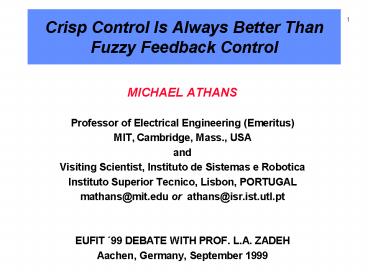Crisp Control Is Always Better Than Fuzzy Feedback Control
1 / 46
Title:
Crisp Control Is Always Better Than Fuzzy Feedback Control
Description:
Ad-hoc interpolation of expert control rule-based system Vast majority of fuzzy applications use this method 2nd generation (Takagi-Sugeno). –
Number of Views:185
Avg rating:3.0/5.0
Title: Crisp Control Is Always Better Than Fuzzy Feedback Control
1
Crisp Control Is Always Better Than Fuzzy
Feedback Control
- MICHAEL ATHANS
- Professor of Electrical Engineering (Emeritus)
- MIT, Cambridge, Mass., USA
- and
- Visiting Scientist, Instituto de Sistemas e
Robotica - Instituto Superior Tecnico, Lisbon, PORTUGAL
- mathans_at_mit.edu or athans_at_isr.ist.utl.pt
- EUFIT 99 DEBATE WITH PROF. L.A. ZADEH
- Aachen, Germany, September 1999
2
Debating Points
- I like Fuzzy Logic as an alternative to
probability theory, especially in applications
involving man-machine interactions - Fuzzy feedback control methods represent inferior
engineering practice, often by people that never
bothered to learn control theory and design - Fuzzy feedback control is a vacuous technology
for the design of high-performance control
systems - Fuzzy control methods are parasitic they
simply implement trivial interpolations of
control strategies obtained by other means - Theological arguments about fuzzification,
defuzzification, nonlinear control, and
inherent robustness are simply nonsense - Fuzzy feedback control has failed to capture and
utilize alternative means in dealing with
uncertainty using Fuzzy Sets and Fuzzy Logic - Prof. Zadeh should communicate to his disciples
the sorry state of affairs in fuzzy feedback
control and tell them to shape-up
3
Crisp Vs Fuzzy Feedback Control
- Crisp control Normative - prescriptive
- Quantitative models of plant dynamics and
disturbances - Precise definition of performance specifications
- Modeling and environmental uncertainty accounted
for - Rigorous optimization-based design
- Fuzzy control Empirical - descriptive
- 1st generation (Mamdani). Ad-hoc interpolation
of expert control rule-based system - Vast majority of fuzzy applications use this
method - 2nd generation (Takagi-Sugeno). Ad-hoc
interpolation of control strategies derived from
crisp feedback control methodologies
- Fuzzy control has failed the noble goal of fuzzy
logic in providing alternatives in dealing with
uncertainty
4
The Joy of Feedback
- Measure system response, including effects of
disturbances, using (noisy) sensors - Compare actual system response to desired system
response at each time - Error signal(s) (Desired response)-(Actual
response) - Use error signals to drive compensator
(controller) so as to generate real-time control
corrections so as to keep errors small for all
time - FEEDBACK ESSENTIAL TO GUARANTEE GOOD PERFORMANCE
IN THE PRESENCE OF UNCERTAINTY
5
Why Feedback?
- Automatic feedback control systems have been used
since the 1930s to provide superior performance
and higher fidelity than manual control systems
requiring human operators - The SCIENCE of Feedback Control was developed to
allow engineering designs that deliver this
superior performance, NOT to duplicate poor human
control performance - The performance payoffs are even more dramatic in
the case of coupled multivariable systems, i.e.
systems with many sensors and control inputs - crisp control theory exploits the tight dynamic
coupling - humans are notorious in lacking ability to
develop control rules for such multivariable
systems - Increased cost of feedback (sensors, actuators,
processors,...) is justified by increased
performance capabilities - sensor/actuator hardware costs greatly exceed
processing costs
6
Fixed Structure Feedback
- Compensator structure does not change (no
learning) - No change in digital processor algorithms that
approximate the solution of compensator
differential equations and gains - Design methodologies available for general
multivariable case using (crisp) robust-control
theories and algorithms
7
Adaptive Feedback Control
- Uncertain plant parameters identified in
real-time and compensator parameters are adjusted
also in real-time
8
Fault-Tolerant Feedback
- Supervisory level monitors for failures
- Failure isolated and identified
- Compensator structure and algorithms modified
9
Crisp Mathematical Control
- Based upon analytical description of plant
dynamics, model errors, environment, constraints,
and performance objectives - Optimal Control Theory
- Used to generate open-loop preprogrammed
control and state variable trajectories as a
function of time - Feedback Control Theory
- Used to ensure precise command-following and
disturbance-rejection performance, in the
presence of uncertainty, using feedback of sensed
variables - stability guarantees are essential
- performance guarantees (in the presence of
uncertain models) are desirable
10
Closed-Loop Stability
- Models have limitations, stupidity does not!
- Feedback control can result in superior
performance - Careless feedback strategies can cause
instabilities - Closed-loop stability must be guaranteed for
family of plants (stability-robustness) - stability guarantees for nominal plant and
nominal plant simulations are not enough - control engineers must be paranoid about
closed-loop stability
11
Crisp Feedback Theory Status
- Start with global nonlinear dynamic model of
plant (nonlinear differential or difference
equations) - Using linearization establish a collection of
linear models in vicinity of operating conditions - Generate linear multivariable dynamic compensator
with guaranteed stability-robustness and
performance-robustness properties for each linear
model - Use gain-scheduling of the parameters of the
linear compensator collection to derive a single
global nonlinear dynamic compensator for the
global nonlinear plant
12
Linearization, Gain-Scheduling
13
Robust Feedback Control Design
- Start with nominal state-space model of linear
MIMO dynamic system - Define bounds on model errors (class of legal
errors) - parametric uncertainty upper and lower bounds
for key coefficients - unstructured uncertainty worst size of dynamic
errors as a function of frequency (bending modes,
torsional modes, actuator/sensor errors, ....) - Model exogenous signals (a key requirement for
superior performance) - power spectral densities of commands,
disturbances and sensor noise - Quantify robust-performance specifications in the
frequency domain
Design is meaningless unless performance specs
are quantified
14
Robust MIMO Feedback Design
- LQG or H2 method
- performance goal minimize RMS errors of
stochastic performance variables - H































